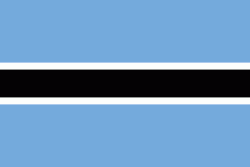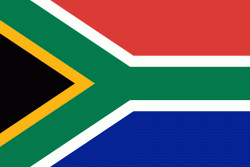Tswana language
Tswana, also known by its native name Setswana, and previously spelled Sechuana in English, is a Bantu language spoken in Southern Africa by about 8.2 million people. It belongs to the Bantu language family within the Sotho-Tswana branch of Zone S (S.30), and is closely related to the Northern Sotho and Southern Sotho languages, as well as the Kgalagadi language and the Lozi language.
Setswana is an official language of Botswana and South Africa. It is a lingua franca in Botswana and parts of South Africa, particularly North West Province. Tswana speaking ethnic groups are found in more than two provinces of South Africa, primarily in the North West, where about four million people speak the language. An urbanised variety, which is part slang and not the formal Setswana, is known as Pretoria Sotho, and is the principal unique language of the city of Pretoria. The three South African provinces with the most speakers are Gauteng (circa 11%), Northern Cape, and North West (over 70%). Until 1994, South African Tswana people were notionally citizens of Bophuthatswana, one of the bantustans of the apartheid regime. The Setswana language in the Northwest Province has variations in which it is spoken according to the ethnic groups found in the Tswana culture (Bakgatla, Barolong, Bakwena, Batlhaping, Bahurutshe, Bafokeng, Batlokwa, Bataung, and Bapo, among others); the written language remains the same. A small number of speakers are also found in Zimbabwe (unknown number) and Namibia (about 10,000 people).
The first European to describe the language was the German traveller Hinrich Lichtenstein, who lived among the Tswana people Batlhaping in 1806 although his work was not published until 1930. He mistakenly regarded Tswana as a dialect of the Xhosa, and the name that he used for the language "Beetjuana" may also have covered the Northern and Southern Sotho languages.
The first major work on Tswana was carried out by the British missionary Robert Moffat, who had also lived among the Batlhaping, and published Bechuana Spelling Book and A Bechuana Catechism in 1826. In the following years, he published several other books of the Bible, and in 1857, he was able to publish a complete translation of the Bible.
The first grammar of Tswana was published in 1833 by the missionary James Archbell although it was modelled on a Xhosa grammar. The first grammar of Tswana which regarded it as a separate language from Xhosa (but still not as a separate language from the Northern and Southern Sotho languages) was published by the French missionary, E. Casalis in 1841. He changed his mind later, and in a publication from 1882, he noted that the Northern and Southern Sotho languages were distinct from Tswana.
Solomon Plaatje, a South African intellectual and linguist, was one of the first writers to extensively write in and about the Tswana language.
Setswana is an official language of Botswana and South Africa. It is a lingua franca in Botswana and parts of South Africa, particularly North West Province. Tswana speaking ethnic groups are found in more than two provinces of South Africa, primarily in the North West, where about four million people speak the language. An urbanised variety, which is part slang and not the formal Setswana, is known as Pretoria Sotho, and is the principal unique language of the city of Pretoria. The three South African provinces with the most speakers are Gauteng (circa 11%), Northern Cape, and North West (over 70%). Until 1994, South African Tswana people were notionally citizens of Bophuthatswana, one of the bantustans of the apartheid regime. The Setswana language in the Northwest Province has variations in which it is spoken according to the ethnic groups found in the Tswana culture (Bakgatla, Barolong, Bakwena, Batlhaping, Bahurutshe, Bafokeng, Batlokwa, Bataung, and Bapo, among others); the written language remains the same. A small number of speakers are also found in Zimbabwe (unknown number) and Namibia (about 10,000 people).
The first European to describe the language was the German traveller Hinrich Lichtenstein, who lived among the Tswana people Batlhaping in 1806 although his work was not published until 1930. He mistakenly regarded Tswana as a dialect of the Xhosa, and the name that he used for the language "Beetjuana" may also have covered the Northern and Southern Sotho languages.
The first major work on Tswana was carried out by the British missionary Robert Moffat, who had also lived among the Batlhaping, and published Bechuana Spelling Book and A Bechuana Catechism in 1826. In the following years, he published several other books of the Bible, and in 1857, he was able to publish a complete translation of the Bible.
The first grammar of Tswana was published in 1833 by the missionary James Archbell although it was modelled on a Xhosa grammar. The first grammar of Tswana which regarded it as a separate language from Xhosa (but still not as a separate language from the Northern and Southern Sotho languages) was published by the French missionary, E. Casalis in 1841. He changed his mind later, and in a publication from 1882, he noted that the Northern and Southern Sotho languages were distinct from Tswana.
Solomon Plaatje, a South African intellectual and linguist, was one of the first writers to extensively write in and about the Tswana language.
Country
-
Botswana
Botswana (, also ), officially the Republic of Botswana (Lefatshe la Botswana, ), is a landlocked country in Southern Africa. Botswana is topographically flat, with approximately 70 percent of its territory being the Kalahari Desert. It is bordered by South Africa to the south and southeast, Namibia to the west and north, and Zimbabwe to the northeast. It is connected by the Kazungula Bridge to Zambia, across the world’s shortest border between two countries.
A country of slightly over 2.3 million people, Botswana is one of the most sparsely populated countries in the world. About 11.6 percent of the population lives in the capital and largest city, Gaborone. Formerly one of the world's poorest countries—with a GDP per capita of about US$70 per year in the late 1960s—it has since transformed itself into an upper-middle-income country, with one of the world's fastest-growing economies. -
South Africa
South Africa, officially the Republic of South Africa (RSA), is the southernmost country in Africa. It is bounded to the south by 2798 km of coastline that stretch along the South Atlantic and Indian Oceans; to the north by the neighbouring countries of Namibia, Botswana, and Zimbabwe; and to the east and northeast by Mozambique and Eswatini. It also completely enclaves the country Lesotho. It is the southernmost country on the mainland of the Old World, and the second-most populous country located entirely south of the equator, after Tanzania. South Africa is a biodiversity hotspot, with unique biomes, plant and animal life. With over 60 million people, the country is the world's 24th-most populous nation and covers an area of 1221037 km2. South Africa has three capital cities, with the executive, judicial and legislative branches of government based in Pretoria, Bloemfontein, and Cape Town respectively. The largest city is Johannesburg.
About 80% of the population are Black South Africans. The remaining population consists of Africa's largest communities of European (White South Africans), Asian (Indian South Africans and Chinese South Africans), and multiracial (Coloured South Africans) ancestry. South Africa is a multiethnic society encompassing a wide variety of cultures, languages, and religions. Its pluralistic makeup is reflected in the constitution's recognition of 11 official languages, the fourth-highest number in the world. According to the 2011 census, the two most spoken first languages are Zulu (22.7%) and Xhosa (16.0%). The two next ones are of European origin: Afrikaans (13.5%) developed from Dutch and serves as the first language of most Coloured and White South Africans; English (9.6%) reflects the legacy of British colonialism and is commonly used in public and commercial life.
